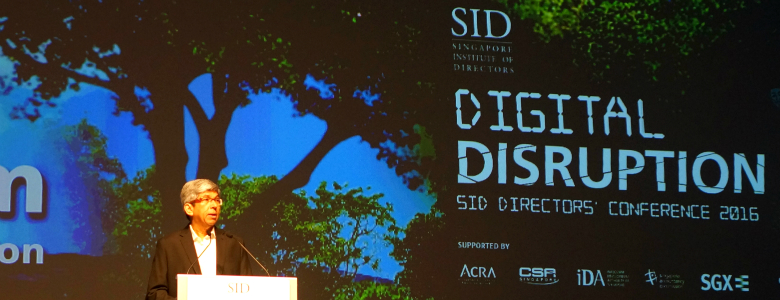Beware the Dark Side of Digital Disruption

Digital disruption featured prominently in Singapore Prime Minister Lee Hsien Loong’s National Day Rally 2016 address; it was what he described as “the defining challenge” facing the Singapore economy.
The new buzzword was also the theme of the SID Directors’ Conference 2016, held at Suntec Singapore Convention & Exhibition Centre on 5 September 2016.
SID, or Singapore Institute of Directors, is the national association of company directors promoting the professional development of directors and corporate leaders.
The conference, now in its seventh year, brought together more than 900 company directors from Singapore and beyond, along with government and business leaders across various industries.
It covered the major trends that are currently impacting the board’s role in ensuring value creation and continued business performance.
Choosing Sides in the Digital Disruption Battle
“Be prepared for disruption,” Mr Willie Cheng, the Chairman of SID, declared during the welcome address. “A spate of disruptive technologies is creating massive opportunities of companies. And with these opportunities, come threats.”
Indeed, with technological change coming at an exponential speed and giving rise to business opportunities, the accompanying risk of being disrupted or cyber-attacked merely grows greater, Mr Cheng added.
Therefore, a company’s board of directors must adequately address the two main aspects of digital disruption: the bright side, or the transformation of businesses and industries, and the dark side, or cyber threats.
SID has been taking the position that the board has a dual role: conformance and performance, according to Mr Cheng.
During the keynote address, Dr John Seely Brown, chief of confusion and co-chairman of Deloitte Centre for the Edge, likened the navigation of these challenges to white water kayaking.
“Reflect a moment on what it takes to be a successful white water kayaker. You have to have an incredible sense of balance and know your own centre of gravity, and you have to be willing to be embedded in these radical fluxes and count on being able to think in the moment,” he said.
“Because in fact, you have a sense of authenticity, which enables you to respond in the moment as you get hit by one disruption after another.”
Describing leadership skills in this ‘white water world’, Dr Brown mused that a kayaker skilfully reads currents and disturbances of the environment around them and interprets the flow of what lies beneath, and learns how to leverage those flows for accelerated action.
Company Reputation and Trust are Vulnerable, Too
Quick thinking like this is essential in today’s connected world, as unfortunately, cyber threats are now more sophisticated than ever, said Dr Yaacob Ibrahim, Minister for Communications and Information and also Minister-in-charge of Cybersecurity, during his guest-of-honour address (Top Photo).
“Our collective effort to leverage digital technology and realise our vision for a smart nation — one that is innovative, agile and connected — must be built on a background of secure, robust infrastructure,” said Dr Yaacob.
“One critical piece of this foundation is cybersecurity.”
He used the example of First Commercial Bank of Taiwan which, just two months ago, was the target of a brazen robbery of TW$81 million (~S$3.4 million) from 14 ATMs across the city.
Investigators had found three different malware programs that were used to hack into the bank’s ATM network, triggering the units to dispense stacks of cash.
“In the wake of the attack, not only was First Commercial Bank forced to take a substantial loss on behalf of its customers, but it also suffered a serious reputational blow,” said Dr Yaacob.
Despite reputation and customer trust being vital to a company’s growth and success, Dr Yaacob also noted that there is a tendency for management teams to dismiss cybersecurity as a non-core business concern, to be left to CIOs and IT departments.
“But investing in cybersecurity is not a back room issue anymore,” Dr Yaacob noted.
“Likewise, boards must keep senior leadership accountable, and must ask hard questions about the tradeoffs that the companies are making that can cost visibility and security.”
The Government’s Supportive Role
At the same time, Dr Yaacob shared, the government is also actively assisting firms with the capacity to be the disruptors, which generates healthy competition within the sector and brings new products and services to the market.
The Infocomm Development Authority (IDA) of Singapore is one such government agency leading efforts in this area, he said.
Dr Yaacob later witnessed the signing of two Accreditation@IDA (A@IDA) Memorandums of Intent with infrastructure and property companies Surbana Jurong and Lendlease; both partnerships will empower IDA accredited companies to expand beyond the government sector by winning projects with the help of both industry players.
“The MOIs will give local early-stage technology companies accredited through A@IDA the opportunity to work on larger infrastructure urban planning projects through partnerships with Surbana and Lendlease,” Dr Yaacob said.
“This will increase the small firms’ exposure to the enterprise sector, helping them to expand into Asia, Africa, the Middle East, and beyond.”
These MOIs will also pave the way for relevant IDA-accredited products to be incorporated into Surbana Jurong’s ‘Smart City in a Box’, a platform that gels various smart city solutions together, and Lendlease’s sustainable properties projects.
After the signing ceremony, there were panel discussions about both the bright and dark sides of digital disruption, followed by breakout sessions focusing on digital disruption in banking, public transport, hospitality and retail.
Besides the plenary and concurrent breakout tracks, an exhibition area called the ‘Digital Den’ featured technologies, products and services of over 25 leading technology companies.
Participants could view exhibits featuring robots, virtual reality, and a slew of software, hardware and business model innovations in a trade fair setting, getting a hands-on experience of how disruptive technologies are helping companies to survive — and thrive.
https://www.tech.gov.sg/media/technews/beware-the-dark-side-of-digital-disruption
